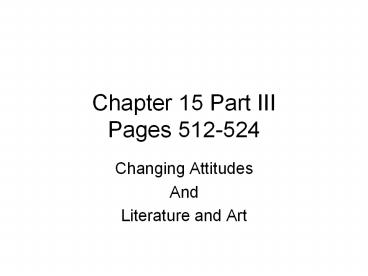Chapter 15 Part III Pages 512-524 PowerPoint PPT Presentation
1 / 11
Title: Chapter 15 Part III Pages 512-524
1
Chapter 15 Part IIIPages 512-524
- Changing Attitudes
- And
- Literature and Art
2
The Status of Women
- Manuals on marriage and the family from the
seventeenth century place women in the home,
reject the double standard on adultery, urged
marriage based on mutual respect and trust, and
reject marriages arranged by parents. - Religious writers of the Reformation did not
express consistent views on women. - Protestants all held that women and men were
spiritually equal. - Catholic thinkers supported the teaching that the
celibate life was the highest form of Christian
life.
3
The Status of Women
- Protestants recognized a mutual right to divorce
that Catholics did not. - The seventeenth century was an age of the
flesh. - a) Protestant and Catholic governments licensed
houses of prostitution. - b) With the closing of convents in Protestant
countries, marriage became the only acceptable
occupation for upper-class Protestant women. - Single women worked in many occupations and
professions. (domestic servants, butchers, shop
keepers, nurses, goldsmiths, mid wives, printing
and weeving) - Protestants believed that celibacy had no
scriptural basis and favored the suppression of
womens religious houses.
4
The Great European Witch-hunt
- Witch-hunting peaked between 1560 and 1660.
- Tens of thousands of witches were executed in
this period.
5
The Great European Witch-hunt
- There are a variety of explanations offered by
scholars for the witch-hunts. - a) Witches explained inexplicable misfortunes.
- b) Communities really believed witches
worshipped the devil. - c) Communities persecuted nonconformists through
charges of witchcraft. - d) Unbridled sexuality attributed to witches was
a psychological projection on the part of their
accusers, whose sexuality was repressed by
Christianity.
6
European Slavery and the Origins of American
Racism
- Before the 1400s virtually all slaves in Europe
were white. - The Ottoman conquest of Constantinople cut off
slaves from the Black Sea region. - With Portuguese voyages to West Africa and the
occupation of the Canary and Madeira islands,
slavery hooked up with sugar culture.
7
European Slavery and the Origins of American
Racism
- Native Americans did not survive long under
conditions of slavery and forced labor. - The Spaniards brought in enslaved Africans as
substitutes. - Modern racism against blacks had its origins in
medieval Christian theology and to a lesser
extent, medieval Arab views of the peoples of
sub-Saharan Africa.
8
The Essay Michel de Montaigne
- Montaigne (15331592), a French nobleman, created
the essay as a means of clarifying his own
thoughts. - Montaigne was a skeptic that is, he rejected the
notion that any single human being knew the
absolute truth. He also rejected the notion that
any one culture was inherently superior to any
other.
9
Elizabethan and Jacobean Literature
- Literature and drama flowered in England during
the reigns of Elizabeth I and James I (r.
16031625). - a) William Shakespeares plays.
- b) The King James Bible.
10
Baroque Art and Music
- The Baroque style had its origins in the desire
of Catholic Counter-Reformation thinkers to
appeal to the common people with an emotional and
awe-inspiring style. - The Baroque in architecture peaked in Italy after
1600, and then moved to Spain, Latin America,
Poland, and other places.
11
Baroque Art and Music
- Peter Paul Rubens (15771640) was the epitome of
the Baroque in painting. - Johann Sebastian Bach (16851750) epitomized the
Baroque style in music (although he was a
Lutheran, not a Catholic).

